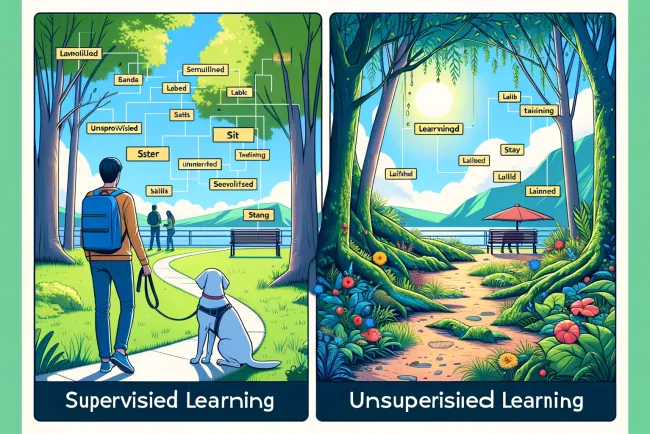What Is Machine Learning and How Does It Work?
know more about machine learning: what it is, how it works, and its key components. Dive into supervised, unsupervised, and reinforcement learning.

What Is Machine Learning and How Does It Work?
Machine learning, a pivotal branch of artificial intelligence (AI), has revolutionized the way computers learn and improve their performance through data analysis. It plays a significant role in enabling computers to recognize patterns, make predictions, and classify data, without the need for explicit programming in every scenario. This article explores the core concepts of machine learning, its types, and its applications across various industries. Key aspects of machine learning include supervised learning, unsupervised learning, and reinforcement learning, each offering unique approaches to understanding and processing data. Let's delve into the foundational elements of machine learning and how they drive advancements in AI.
Key Aspects of Machine Learning
Machine learning is structured around different learning paradigms, each with its own approach to data processing and model training. These paradigms are designed to help computers learn from data and make informed decisions based on specific algorithms and models.
- Supervised Learning
Supervised learning is a technique where models are trained on a labeled dataset. Each example in the dataset includes an input-output pair, allowing the model to learn the relationship between them. The ultimate goal is to create a mapping that allows the model to make predictions on new, unseen data. Common applications of supervised learning include classification tasks, like email spam detection, and regression tasks, such as predicting housing prices.
- Unsupervised Learning
Unsupervised learning, in contrast, uses datasets that are not labeled. The primary objective is to find patterns, relationships, or structures within the data without explicit guidance. Common unsupervised learning tasks include clustering, where data points are grouped based on similarities, and dimensionality reduction, which aims to simplify complex data while retaining important information.
- Reinforcement Learning
Reinforcement learning is unique in that it involves training models through interaction with an environment. The models receive feedback in the form of rewards or penalties based on their actions. The aim is to learn a strategy or policy that maximizes cumulative rewards over time. This type of learning is commonly used in robotics, game playing, and autonomous vehicles.
Applications of Machine Learning
Machine learning has found applications in numerous industries, driving innovation and improving efficiency. Its versatility allows it to be applied to a wide range of problems, from simple data analysis to complex decision-making processes.
Healthcare

In healthcare, machine learning is used for early disease detection, personalized treatment plans, and predictive analytics to identify at-risk patients. It has the potential to revolutionize medical diagnostics and patient care.
Finance

In the financial sector, machine learning is employed for fraud detection, risk assessment, and algorithmic trading. By analyzing large volumes of financial data, machine learning models can identify patterns and make predictions that support financial decisions.'
Marketing

Machine learning is a powerful tool in marketing, enabling personalized recommendations, customer segmentation, and targeted advertising. It helps businesses understand customer behavior and tailor their marketing strategies accordingly.
Underlying Concepts and Techniques
Machine learning is built on a foundation of statistical and mathematical principles. It encompasses a wide range of algorithms and techniques that vary in complexity and application.
Common Algorithms
Several algorithms are commonly used in machine learning, each suited to different types of tasks. These include linear regression, decision trees, neural networks, support vector machines, and ensemble methods like random forests and boosting. Understanding the strengths and weaknesses of each algorithm is key to successful model selection.
Data Preparation and Feature Engineering
The success of a machine learning project relies heavily on data preparation and feature engineering. Data preparation involves cleaning and formatting data to ensure it is suitable for training. Feature engineering is the process of selecting, modifying, or creating features that improve the performance of the model.
Model Training and Evaluation
Training a machine learning model involves adjusting parameters to optimize its performance on a specific task. Evaluation metrics, such as accuracy, precision, recall, and F1-score, are used to assess the model's effectiveness. It's crucial to avoid overfitting, where the model performs well on training data but poorly on unseen data.
FAQs
What is the difference between AI and machine learning?
AI is a broad field that encompasses various technologies, including machine learning. Machine learning is a subset of AI focused on developing algorithms and models that allow computers to learn from data.
How does reinforcement learning differ from supervised learning?
Reinforcement learning involves interaction with an environment and receiving feedback in the form of rewards or penalties. Supervised learning relies on labeled datasets with known input-output pairs.
What are some common applications of unsupervised learning?
Unsupervised learning is commonly used for clustering and dimensionality reduction. It helps identify patterns and relationships in data without explicit guidance.
How do machine learning models improve over time?
Machine learning models improve through training and feedback. As they process more data and receive updates, they can refine their predictions and become more accurate.
Conclusion and Further Resources
Machine learning is a rapidly evolving field with diverse applications. Understanding its core concepts and techniques is essential for harnessing its potential. If you're interested in learning more about AI and machine learning, consider exploring further resources and tools that provide deeper insights into this exciting domain.
1- How Machine Learning Works: easy step by step Guide
What's Your Reaction?






















